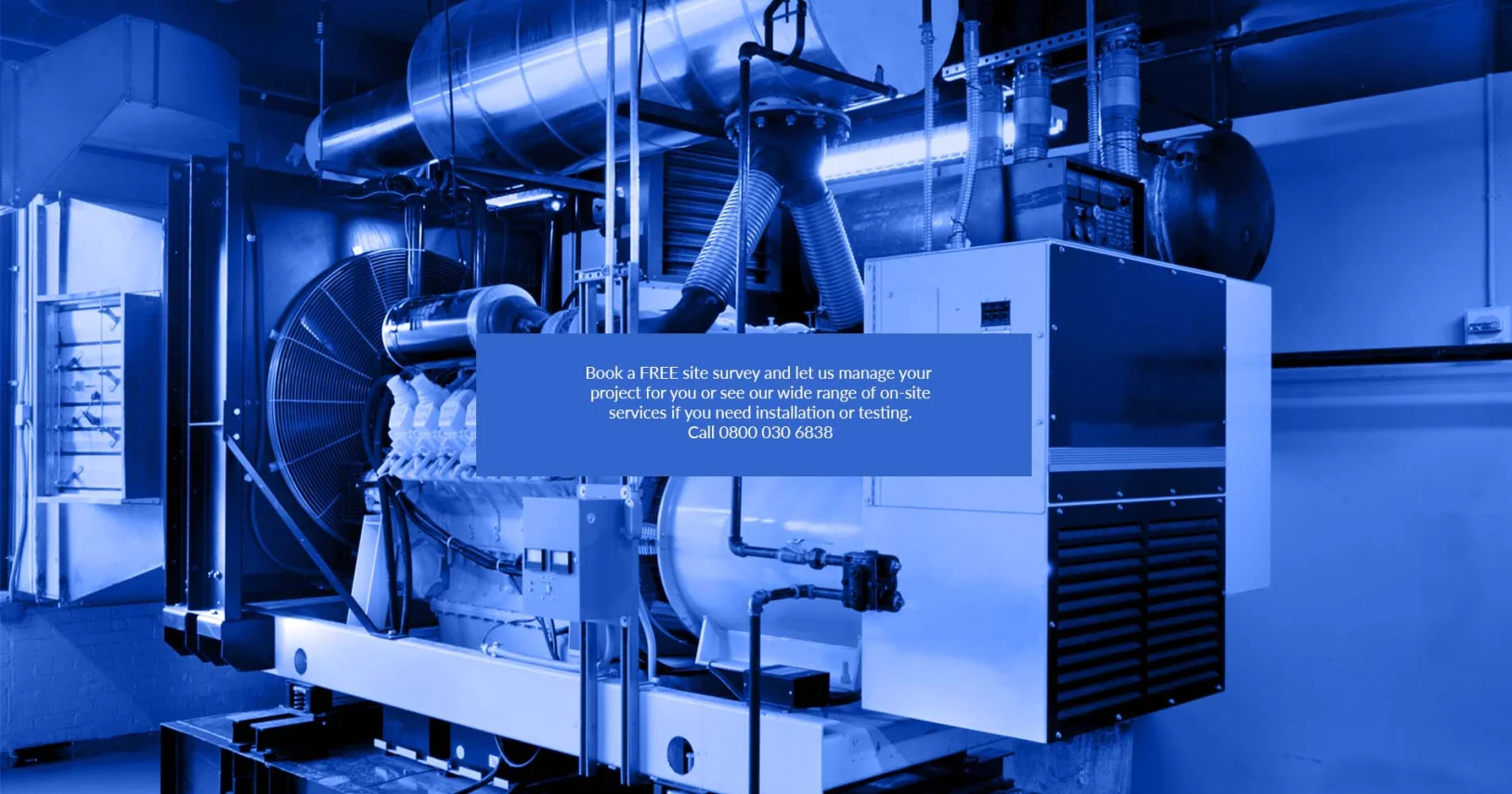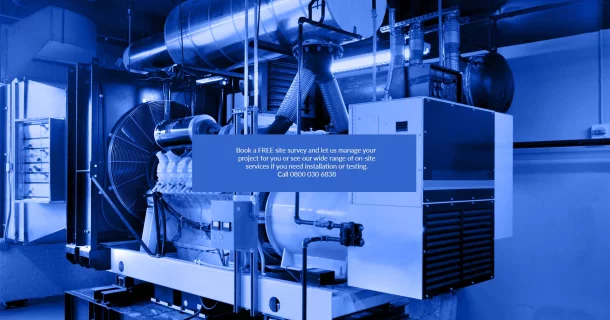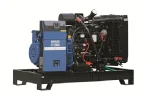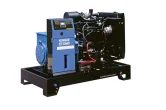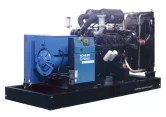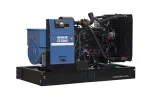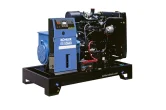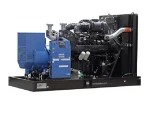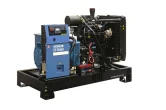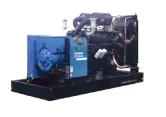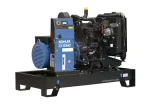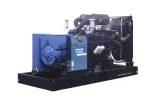The runtime that a generator can provide power for is a function of the load placed onto the generating set and the size of the tank which is usually measured in litres. Generators are generally sized in kVA or kW and are supplied with an 8-hour, 24-hour (day tank) or 48-hour tank. Check the generator specification for the litres-per-hour consumption rate and capacity of the fuel tank. Our projects team can provide additional bunded tank capacity and a refueling service.
Standby Generators to Provide Emergency Backup Generator Power During Power Outages
Server Room Environments supplies a range of standby generators to protect critical IT facilities from prolonged mains power supply failures. Our project managers provide a complete service including site surveys, design, installation, electrical works including automatic mains failure (AMF) panels, fuelling, monitoring and maintenance. We supply backup generators from leading brands for use in server room and data centre power protection plans.
- UPS Systems (601)
- UPS Solutions (602)
- UPS Technologies (586)
- Power Distribution (297)
- Backup Power (458)
Generator UPS Sizing Chart
Prime power refers to the continuous rating of the generator. When installed with a UPS system, a generator is installed to provide standby power. The UPS battery provides sufficiently long enough for the generator to automatically start before taking over the AC supply to the uninterruptible power supply.
| Prime Power | Standby Power | Phases | UPS |
|---|---|---|---|
| 33kVA | 30kVA | 3/3 | 20kVA |
| 44kVA | 40kVA | 3/3 | 30kVA |
| 66kVA | 60kVA | 3/3 | 40kVA |
| 77kVA | 70kVA | 3/3 | 50kVA |
| 88kVA | 80kVA | 3/3 | 60kVA |
| 110kVA | 100kVA | 3/3 | 80kVA |
| 132kVA | 120kVA | 3/3 | 90kVA |
| 165kVA | 150kVA | 3/3 | 120kVA |
| 200kVA | 182kVA | 3/3 | 140kVA |
| 275kVA | 250kVA | 3/3 | 200kVA |
| 550KVA | 500kVA | 3/3 | 400kVA |
| 630kVA | 573kVA | 3/3 | 450KVA |
| 697kVA | 634kVA | 3/3 | 500kVA |
| 825kVA | 750kVA | 3/3 | 600kVA |
The UPS size shown is a based on the generator being sized to provide 1.2x the power output of the UPS and is a guide only. Generators typically cover more than the UPS load (critical) with other loads being Essential (office lighting, HVAC, security, and lifts) to some non-essential loads. Each building has different needs and each organisation has different business continuity requirements.
Open-Frame or Canopied Back-up Generators
Generators from Server Room Environments can be supplied as open-frame or enclosed sets with canopies provided both weather-proofing and also acoustic noise attenuation. Noise levels are an important consideration for generators and must meet site and local authority planning regulations.
Containerised Generators
For rapid response and temporary solutions Server Room Environments can also supply containerised generators including uninterruptible power supplies, battery sets, cabling and LV switchboards. A containerised solution can be used where there is no space except outside an existing building or when temporary supply is required.
Refuelling Generators
Some of our generators have internal fuel tanks and others are supplied with feeds from an external tank. A typical day-tank (8hour operation) can be internal with options for 24 and 48hour tanks. Our fuel tanks are fully bunded to protect the environment from leakages and we provide a refuelling and fuel polishing service. Our generating sets run from 5kVA to 1MVA and can be operated in parallel for datacentres and other similar building applications that require redundancy or larger sets.
Temporary Diesel Power Backup Generators
As well as new installations, Server Room Environments can also provide temporary power solutions where clients can rent generating sets for a set time. This service also provides load banks and UPS systems on hire.
Standby Generator Mechanical and Electrical Installation
Our project managers can co-ordinate all aspects of your new generator installation including mechanical engineering and electrical contractor works. This can include exhaust ducting and fuel pipes, electrical installation and connection of the generator for local distribution and remote monitoring.
Standby Backup Power Generator Guide
Standby generators provide alternative power to the grid for a range of applications. The projects team at Server Room Environments have built an extensive knowledge base when it comes to specifying, installing and maintaining generators in critical power datacentre and server room back-up power projects. Some key considerations for these types of projects include:
- Power: the generator must be sized to support the load with a built-in safety factor. Generator sets are not Unity Power Factor rated and the most common power factor used is 0.8 meaning an 80kW generator can provide 100kVA of apparent power. Load step is another important issue to consider as generators cannot always provide all their power output instantaneously. Load start-up currents should also be considered as these can be far more than normal running currents.
- Performance: generators have defined performance classes stated in ISO8528 Part 1 and must be matched to the load size and electrical characteristics required in terms of voltage and frequency.
- Rating: generator sets can be rated depending on whether the set is to be used as a Continuous Operating Power (COP), Prime Rated Power (PRP) or Standby back-up power set with a Limited Time Power (LTP) or Emergency Standby Power (ESP) rating. The difference between these ratings can be as high as 30%.
- Fuel: diesel is the most commonly used fuel with biodiesel considered a more environmentally friendly alternative if it does not have to be stored for long periods. Other fuel types can include natural gas and LPG.
- Environment: high temperatures and altitudes can limit power whilst low temperatures can lead to start-up issues.
- Autonomy: normally expressed in hours with a load percentage. The autonomy will influence the size of set and fuel options.
- Regulations: in the European Union a generator must be CE marked. Other standards and regulations may apply relevant to the country of operating.
- Physical: for any generator installation there should be a Risk Assessment and Method Statement (RAMS) document generated to ensure that all the inherent risks are investigated and mitigated. These risks can include generator fire, fumes and hot gases and noise pollution.
- Electrical: a generating set must be chosen based on the phase voltage and frequency required. A generator must be installed with correctly rated protective devices including earthing and neutral-earthing arrangements.
- Grid Tied and Off-The-Grid: a G59 connection may be required if the generator is to be used to supply back-up power into the grid as part of the National Grid STOR Demand Side Response (DSR) program.
- Bunding: all tanks over 200 litres in sizes must be bunded to prevent accidental leakage into their environment.
Generator Projects
Home Backup Power
Whilst the majority of generators we supply are for server rooms and data centres, smaller generating sets are available for domestic applications where they can provide backup power during power outages. Home generator systems provide backup power with auto start and power down features. An uninterruptible power supply is used to provide backup power as the standby generator comes up to speed and full power.
Please contact our projects team for more information and prices on our single and three phase diesel generators. We provide generating sets for new installations and temporary hire solutions.

Earn SRE points on all online purchases with double points on selected products
























